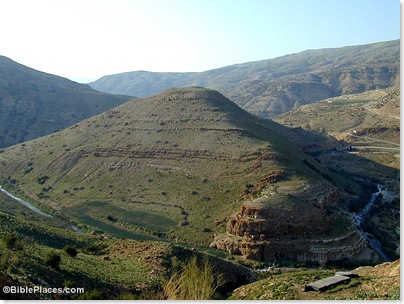Many will probably quickly skip over this article, but those who have visited or studied the sites of Penuel and Mahanaim will be interested, though the article mentions neither possible identification. Excavations have (finally!) begun at Tall adh-Dhahab, often identified by biblical scholars as the place where Jacob wrestled with the angel, where David fled from Absalom, and where Jeroboam built his Transjordanian capital. But what was not known (at least to me) was the Herodian attraction to the site. This makes perfect sense, given its history. A professor of theology at Technische Universität Dortmund began work last year. From their recent press release.
This year Thomas Pola, professor for theology at TU Dortmund, and his team have continued the excavations in the East Jordan Land. With their findings on the mountain Tall adh-Dhahab (West) in the Jabbok Valley the archeologists could substantiate one assumption: everything points to the fact that the building remains from the Hellenistic and Roman era, found in 2006, were part of a yet unknown monumental building of Herod the Great (73-4 BC).
This assumption is based on the floors of one of the discovered peristyle yards (yards enclosed by continuous columns) which the archeologists were able to excavate. Prof. Pola sees the parallels with the architecture of Herod’s West Jordan Alexandreion as prove that there also was a monumental building of Herod the Great on the plateau of the mountain Tall adh-Dhahab. That would mean that in addition to his reign over the West Jordan Land, the Jewish king had a security system with which he could have controlled the ancient long-distance traffic in the middle Jordan Valley and the access ways to the plateau of the East Jordan Land.
Above that, the team of Prof. Pola for the first time discovered a layer from the late Bronze Age or the Early Iron Age on a natural terrace directly underneath the plateau. The ruins of a tower from the city wall at least show three building phases. “On the level of the oldest building phase we took samples from a burnt layer. A C14-analysis carried out by Prof. Manfred Bayer (Physics at TU Dortmund) showed that the charcoal originates from the time 1300 to 1000 BC. At this location we will continue to work in 2008.”
Finally Prof. Pola’s team discovered the purpose of the monumental military facility half way up the mountain: it is a casemate wall. It is supposed to have been finished in Roman times. This is yet another argument for the identification of the mountain with the stronghold Amathous mentioned in the ancient world. The historian Josephus (37 to 100 AD) described Amathous as the biggest stronghold in the East Jordan Land.
The press release continues here.

4 thoughts on “Excavations of Herodian Ruins at Dhahab (Penuel/Mahanaim)”
Since I am contemplating excavations at Dhahab (East), I visited both sites last January and the excavations at (West) had been on-going for some time. I would suggest it is Mahanaim and the eastern and smaller twin Penuel. Of course, the discoveries at Dhahab west may now support it as Penuel and the capital of Jeroboam in exile rather than the smaller site across the river. Only continued excavation on both sites will give a clear picture of the exact nature of the region from the Iron II – Roman. The sister site has undergone extensive digging by robbers who uncovered a massive stone wall at least 25 feet high and 40 feet long. They are, of course, looking for the “dhahab” – the gold of which the name boasts (possibly a reference to the Hellenistic (?) tomb that is cut approximately 50-75 ft into the base of the hill…..
Dr M – if you join the dig or otherwise learn anything about the excavations and are able to pass them on, I’d love to keep our readers informed.
Thanks for the article and links Todd! At he link, there was a reference to “carve” (sic?) drawings from the 9th Century. What are “carve” drawings (if correctly spelled) and is the century referenced BC or AD?
Thanks!
I would guess this is a reference to relief inscriptions, and the century is B.C.